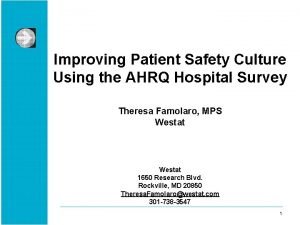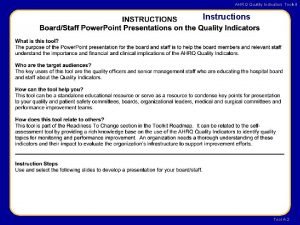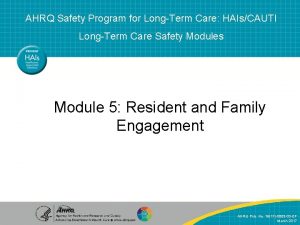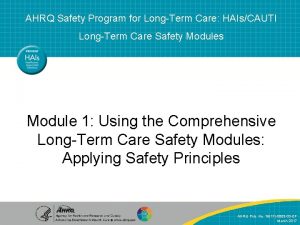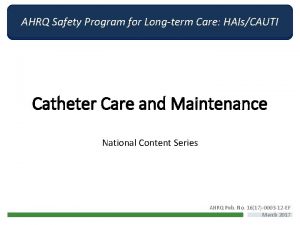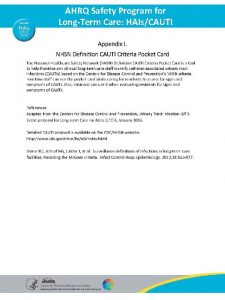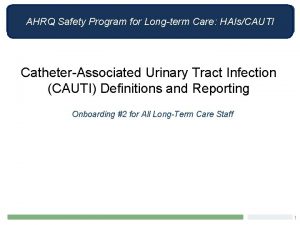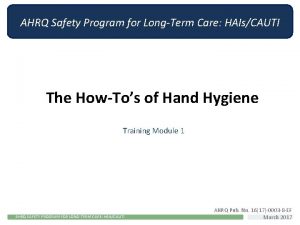AHRQ Safety Program for LongTerm Care HAIsCAUTI Urinary










- Slides: 10

AHRQ Safety Program for Long-Term Care: HAIs/CAUTI Urinary Catheter Types and Care for Residents With Catheters AHRQ Pub. No. 16(17)‐ 0003‐ 11‐EF March 2017

Learning Objectives Upon completion of this module, clinicians and staff who care for residents with catheters will be able to— • explain the similarities and differences between the four different types of catheters; • explain ways to prevent catheter‐associated urinary tract infections; and • identify some common errors when caring for catheters. AHRQ SAFETY PROGRAM FOR LONG‐TERM CARE: HAIs/CAUTI Maintenance │ 2

Indwelling Urinary Catheter Entry Pathways for Microbes 1 Bladder • Entry during insertion • Bacteria movement up the catheter Urethra (Urinary tract entrance) Urine Collection Bag Image source: Maki DG, Tambyah PA. Engineering out the risk of infection with urinary catheters. Emerg Infect Dis. 2001 Mar-Apr; 7(2): 342 -7. http: //wwwnc. cdc. gov/eid/article/7/2/7 0 -0342_article. CMS, State Operations Manual, 2014. AHRQ SAFETY PROGRAM FOR LONG‐TERM CARE: HAIs/CAUTI • Breaks in the catheter tubing or collection bag • Contamination of the catheter tubing or collection bag Maintenance │ 3

Alternatives to Indwelling Urinary Catheter Types • Suprapubic catheters • Straight catheters • External “condom” catheters AHRQ SAFETY PROGRAM FOR LONG‐TERM CARE: HAIs/CAUTI Maintenance │ 4

Hygiene and Standard Precautions Assisting the Nurse With Catheter Insertion 2 • Wash your hands! • Don gloves and gown • Help the resident to get comfortable in a supine position and assist the nurse as needed • Catheter insertion is done as a sterile technique. Do not touch the sterile field • Assist to place and secure the catheter drainage bag below the level of the bladder and off the floor • Remove gown and gloves and wash hands! AHRQ SAFETY PROGRAM FOR LONG‐TERM CARE: HAIs/CAUTI Maintenance │ 5

Drainage Bag 2 • Only trained staff should empty the urine collection bag and rinse/store containers • Follow manufacturer instructions on use • Empty drainage bags regularly (at least once per shift) • Stabilize the catheter and drainage bag • Keep drainage bag below level of bladder at all times OFF floor • Consider where to place the drainage bag during resident’s daily activity – – – Wheelchair Walker (clamp or hook) Bed Dining/activity area Lounge/reading chair (peg on side) AHRQ SAFETY PROGRAM FOR LONG‐TERM CARE: HAIs/CAUTI Maintenance │ 6

Maintenance Avoiding Common Mistakes 3 • Wash hands BEFORE and AFTER any contact with urinary catheter, tubing, or bag • Keep bag below bladder at all times without kinking • When emptying bag, do not let outlet port touch ANYTHING • Drain into a container used only for ONE resident • Sampling port must be DISINFECTED before any use • Only STERILE needle/syringe can be used to aspirate urine AHRQ SAFETY PROGRAM FOR LONG‐TERM CARE: HAIs/CAUTI Maintenance │ 7

Maintenance Care of Indwelling Urinary Catheter 3 • Use standard precautions before contact with catheter, tubing, or bag • When performing peri‐care use only soap and water • Periurethral area should NOT be cleaned vigorously or with antiseptic solutions • Keep the catheter and all tubing from kinking/obstruction • Indwelling urinary catheter and suprapubic catheter systems must be kept CLOSED • If any disconnection of tubing or bag leakage, replace it • Make sure you don’t contaminate catheter outlet valve when emptying the collection bag • Certified nursing assistants are daily hands on the “front line” between residents and families, and potential infection‐causing microbes AHRQ SAFETY PROGRAM FOR LONG‐TERM CARE: HAIs/CAUTI Maintenance │ 8

Teaching Family and Residents About Catheters 4, 5 Resources for educating residents and families can be found on the following Web sites: Centers for Disease Control and Prevention— https: //www. cdc. gov/HAI/ca_uti/uti. html National Consumer Voice— http: //theconsumervoice. org/issues/other‐issues‐and‐resources/infection‐prevention AHRQ SAFETY PROGRAM FOR LONG‐TERM CARE: HAIs/CAUTI Maintenance │ 9

References 1. Maki DG, Tambyah PA. Engineering out the risk for infection with urinary catheters. Emerg Infect Dis. 2001; 7(2): 342‐ 7. http: //wwwnc. cdc. gov/eid/article/7/2/70‐ 0342_article. 2. Willson M, Wilde M, Webb M, et al. Nursing interventions to reduce the risk of catheter‐associated urinary tract infection: part 2: staff education, monitoring, and care techniques. J Wound Ostomy Continence Nurs. 2009; 36(2): 137‐ 54. 3. Lo E, Nicolle LE, Coffin SE, et al. Strategies to prevent catheter‐associated urinary tract infections in acute care hospitals: 2014 update. Infect Control Hosp Epidemiol. 2014; 35(S 2): S 32‐S 47. 4. Catheter‐Associated Urinary Tract Infections. October 2015. Centers for Disease Control and Prevention. https: //www. cdc. gov/HAI/ca_uti/uti. html. 5. Infection Prevention: Catheter‐Associated Urinary Tract Infection. 2016. The National Consumer Voice for Quality Long‐Term Care. http: //theconsumervoice. org/issues/other‐ issues‐and‐resources/infection‐prevention. AHRQ SAFETY PROGRAM FOR LONG‐TERM CARE: HAIs/CAUTI 10

